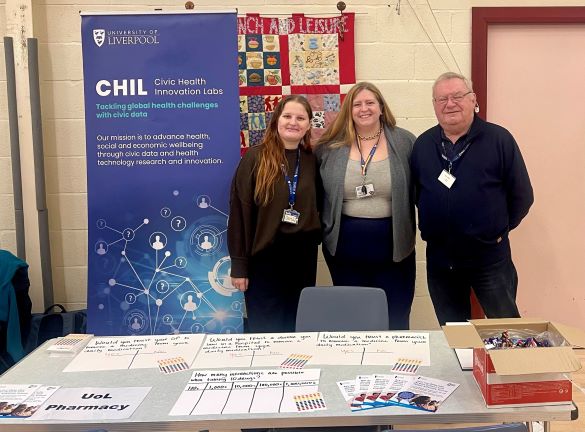CHIL and DynAIRx Staff Take Part in Community Outreach Events

In 2024 the Civic Health Innovation Lab (CHIL) team attended events within the Liverpool City Region to connect with the community. Talking to people about our research is a big part of what we do at CHIL. Community events allow us to share our work with the public and are excellent opportunities for engagement.
Ainsdale Health Fare
In October, the Ainsdale Health Fare took place at Ainsdale Methodist Church. The annual health fare gives free flu jabs to those who are eligible. About 1,000-1,200 people attended the two-day event. Visitors could stop by stands offering advice, health screenings, and find out about research projects.
The event was an excellent opportunity for us to meet people within the local community and talk about the DynAIRx project. We ran two activities throughout the days:
- Trust exercise – we asked people whether they would trust a GP, hospital doctor, and pharmacist to remove one of their daily medicines. This showed that people were very trusting of GPs but would want to seek additional advice from their GP if a hospital doctor or pharmacist made the recommendation. If people had an existing relationship with their pharmacist, this increased their willingness to trust them.
- Interactions exercise – we asked people to guess how many ways medicines could affect each other if someone is taking 10 different ones. Most people were shocked to find that there were over 3 million possible interactions. This led nicely into discussions about the use of Artificial Intelligence (AI) for analysing these interactions. People were supportive of the AI highlighting possibly dangerous combinations to healthcare professionals.
Meet the Scientists Event
Meet the Scientists is an annual series of interactive science days for families, hosted by the University of Liverpool and World Museum Liverpool. The CHIL team took part in two events across October and November at Liverpool World Museum and Eureka! in Birkenhead. Each day saw more than 1,000 people, mostly families with school aged children. Researchers created hands-on activities related to their area of research for children to try out as described below. It was a great day out for children to explore different research projects, and to inspire them to learn more about science.
- October event: the Civic Data Cooperative and DynAIRx team asked children to think about how they spend their day and explained how their activities become data. For example, your phone alarm clock sends information about wake-up patterns to your phone provider and if you take a bus to school, your travel patterns are recorded when you tap in. This data can be used to make change, for example if lots of people use the same travel route at the same time, providers can put on an additional bus service at that time of day. It was an eye-opening event that sparked conversations about what data is and what we do with this information.
- November event: DynAIRx had an exhibit called “Many Medicines!”. The team prepared a medicine colouring exercise and a timetable exercise where older children had to create a schedule around taking 10 medications throughout the day. For example, some needed to be taken twice, some with food, some on an empty stomach etc. This showed the difficulty that can come with taking lots of medicines every day. It led to discussions about how AI tools can be used to help people who take lots of medicines. As a bonus activity, we had a badge making station which was a great hit with children of all ages.
The hands-on activities helped to make conversations around research easier as they helped set the scene for the discussions. They also allowed people, whether parents or children, to learn more about research and better understand why research in these areas is so important. We heard feedback from families who attended who said: “Everyone engaged so well with the children and took their time with them. All the activities were truly fun. It was very educational, not just for kids but adults as well.”
Summary
Attending community events gives researchers a chance to engage with people who would not normally be involved in research. At Ainsdale Health Fare, we got to speak with people who have experience with medicines reviews and taking multiple medications. At Meet the Scientists, we spoke with families about how data is managed and how it might feel to need to take lots of medicines to manage health. Both events helped researchers to think about how they can make their work understandable and meaningful for the community. Participating in community events is a good reminder that research can be both fun and impactful.
Community outreach is a powerful tool for creating a sense of shared purpose. It is important for ensuring maximum impact from our research projects and we look forward to attending more events in 2025.
We thank Alan Griffiths for his valuable insights and contributions in shaping this blog post to ensure it is accessible and clear to a wide audience.